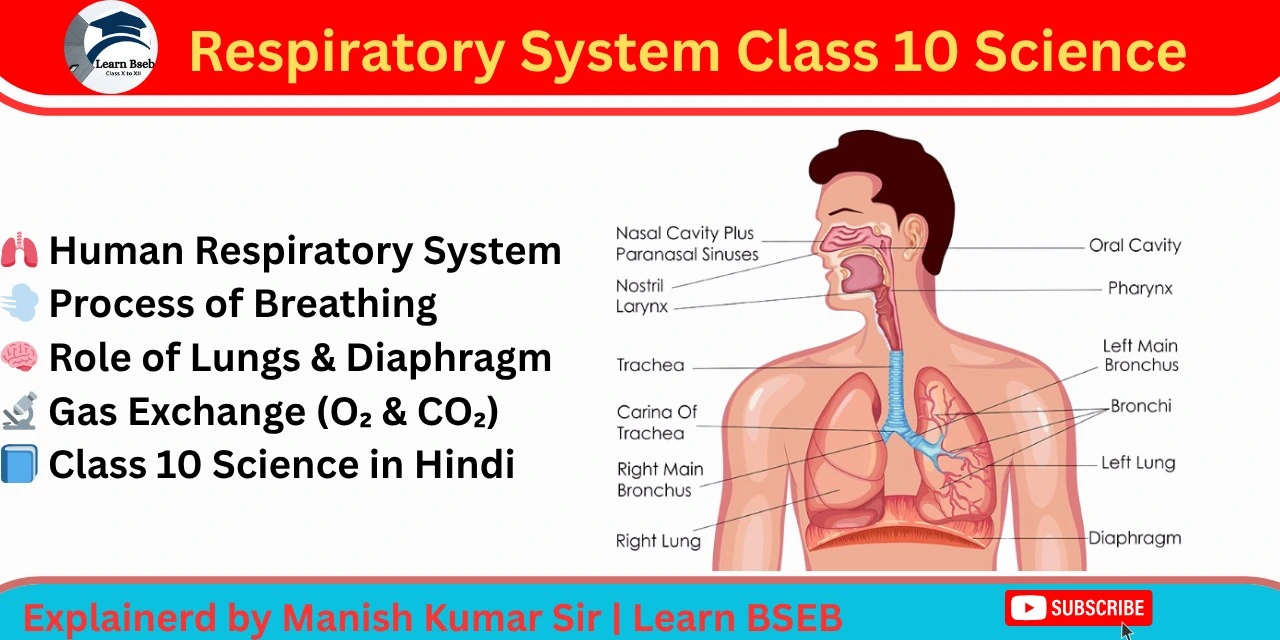Introduction:
The function of the respiratory system in the human body is to provide the body with the oxygen necessary for life and to expel carbon dioxide. Through the respiratory system, we not only maintain life but also ensure energy production and the functioning of the body cells. This topic is important in Class 10 Science and is frequently asked in the exam. In this article, we will examine all aspects of the human respiratory system in detail.
Meaning of Human Respiratory System:
The human respiratory system is an organ system that exchanges air. In this, oxygen is taken inside the body and carbon dioxide is taken out. The respiratory system is very important for the energy production of the body.
Organs of the Human Respiratory System:
The following are the main organs in the human respiratory system:
Nose:
- The nose is the main route of air entry.
- It contains hair and mucus that filter dust and bacteria.
- Cilia and the mucous membrane are present inside the nose.
Pharynx:
- The air coming from the nose moves through the throat (Pharynx).
- It separates the passage of air and food.
Larynx:
- It is also called the voice box.
- Sound originates from here.
- It plays an important role in respiration and voice production.
Airway (Trachea):
- The airway, or Trachea, transports air to the lungs.
- It is surrounded by C-shaped cartilage rings, which keep it open.
Bronchi:
- The trachea divides into two branches called the Right and Left Bronchi.
- These distribute air within the lungs.
Lungs:
- Lungs are the main organ of respiration.
- It is filled with small air cells called alveoli.
- The exchange of oxygen and carbon dioxide takes place in the alveoli.
Diaphragm:
- The diaphragm is a muscle that helps in breathing.
- It is located below the lungs and plays a main role in respiration.
Human Respiration Process
There are two types of human respiration:
- External Respiration:
- This happens in the lungs.
- Oxygen from the air enters the blood, and carbon dioxide leaves the blood.
- Internal Respiration:
- This happens at the level of cells.
- Cells use oxygen to produce energy (ATP) and produce carbon dioxide.
Breathing:
- Inhalation: The diaphragm moves downwards and the lungs expand.
- Exhalation: The diaphragm rises and the lungs contract.
Important organs in human respiration and their characteristics (Key Features of Respiratory Organs):
Name of organ | Work |
Nose | Filtering, heating and humidifying the air |
Throat | Separation of air and food |
Throat | To produce sound |
Trachea | Airway to lungs |
Bronchi | Distribution of air in the lungs |
Lungs | Exchange of gases (Oxygen & CO₂) |
Diaphragm | Assist in breathing |
Types of Human Respiration:
- Oxygenated Respiration (Aerobic Respiration):
- In this, glucose is converted into energy with the help of oxygen.
- Energy, carbon dioxide and water are created.
- Respiration without oxygen (Anaerobic Respiration):
- Occurs in the absence of oxygen.
- Energy is produced from glucose, but in small amounts.
- Lactic acid and other waste products are formed.
Tips for a Healthy Respiratory System:
- Exercise daily.
- Use masks in polluted areas.
- Avoid smoking.
- Eat a balanced diet, which includes vitamins C and E.
- Spend time in green spaces.
Class 10 Science Objective Questions (Objective Question-Answer)
Question 1: What is the main function of the respiratory system?
Answer: Providing oxygen to the body and expelling carbon dioxide.
Question 2: Where does the exchange of gases take place in the lungs?
Answer: In the Alveoli.
Question 3: Which is the main muscle in respiration?
Answer: Diaphragm.
Question 4: The Trachea is connected to which organ?
Answer: From the larynx.
Question 5: What is the difference between external respiration and internal respiration?
Answer: External respiration occurs in the lungs, and internal respiration occurs in cells.
Question 6: What are the types of human respiration?
Answer: Aerobic and Anaerobic respiration.
Question 7: What is the function of the nose in respiration?
Answer: Filtering, heating and humidifying the air.
Conclusion:
The human respiratory system is extremely important for life. It provides us with oxygen and expels carbon dioxide. For Class 10 Science students, knowledge of the respiratory system is often useful in the examination. The right eating habits, clean air and regular exercise keep the respiratory system healthy.
Download PDF – Human Respiratory System Class 10 Science (50 Objective Questions & Answers)
This PDF contains 50 important objective questions and answers from the Human Respiratory System chapter of Class 10 Science.
It’s an excellent resource for quick revision and exam preparation.

